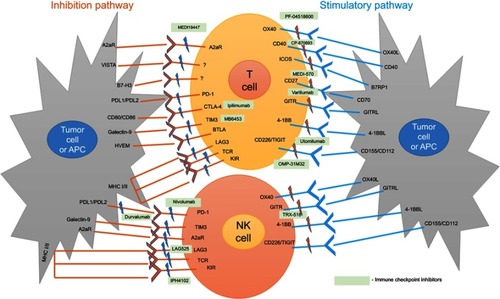Figures & data
Figure 1 Timeline of treatment for SCLC. This timeline illustrates the standard of care therapies and new therapies that have been approved by the FDA.

Figure 2 Immunosuppressive and immunostimulatory checkpoints and their targets. T cells recognize antigens presented by MHC complex on APCs or tumor cells through T cell receptor (TCR). Many of the ligands bind to multiple receptors; some deliver co-stimulatory signals, whereas others deliver inhibitory signals. Full activation of T cells is mediated by binding of CD28 to B7. CTLA-4 competes with CD28 for binding to B7 and transmits an inhibitory signal suppressing T cell activation. PD-1 is expressed on T and NK cells after antigen exposure. Following binding of PD-1 to its ligands, such as PD-L1/PD/L2 (expressed on tumor cells or APCs), an inhibitory signal turns off the immune response mediated by activated T and NK cells. A2aR is expressed on T and NK cells, similar to PD-1. As in CTLA-4 and PD-1 pathways, a significant influence of A2aR signaling on Tregs and effector T cells is likely to be the fundamental driving force behind its immunosuppressive effect. TIM3 is an inhibitory receptor expressed by T and NK cells that interacts with soluble or cell surface galectin 9 to negatively regulate T and NK cell function. BTLA is an inhibitory receptor that is structurally and functionally related to CTLA-4 and PD-1 and expressed by T cells. LAG3 is a receptor that forwards inhibitory signals to activated T and NK cells through LAG3/TCR-MHC interaction, leading to downregulation of immune responses. KIR receptors are expressed on NK cells and to a lesser extent on CD8+ T cells. The binding of inhibitory KIRs (inhKIRS) to their ligands (HLA class I molecule) protects normal cells against the NK cell attack. In contrast, in cancer, higher expression of inhKIRs on the surface of NK and T cells promotes a downregulation of their function. OX40 is a stimulatory receptor, highly expressed by activated T cells and to a lesser degree by NK cells. OX40 and its ligand OX40L play a pivotal role in the activation, potentiation, proliferation, and survival of T cells and in modulating NK cell function. CD40 is a stimulatory receptor expressed on T cells. The interaction between CD40 and CD154 stimulates cytokine secretion by B cells with subsequent T cell activation and tumor cell death. The levels of ICOS, a specific T cell co-stimulatory receptor expressed on T cells, are upregulated in activated T cells, particularly after the use of anti-CTLA-4 therapies. CD27 is a stimulatory receptor expressed on T cells. CD27–CD70 binding results in a potent signal that activates and differentiates T cells into effector and memory cells and boosts the level of B cells. GITR is a co-stimulatory receptor expressed on T and NK cells. 4-1BB is an inducible co-stimulatory receptor expressed on T and NK cells. The interaction between 4-1BB and 4-1BBL triggers subsequent immune cell proliferation and activation, particularly of T and NK cells. TIGIT is a member of CD28 family-like receptors expressed on T and NK cells. It exerts direct immunosuppressive effects on these cells and indirectly increases the release of immunoregulatory cytokines, decreases the production of interferon-γ and IL-7, and prevents maturation of dendritic cells.

Table 1 Complete trials of immunotherapy agents in SCLC
Table 2 Ongoing trials of immune checkpoint agents in SCLC
Table 3 Ongoing trials: next generation of immune checkpoint agents in SCLC
